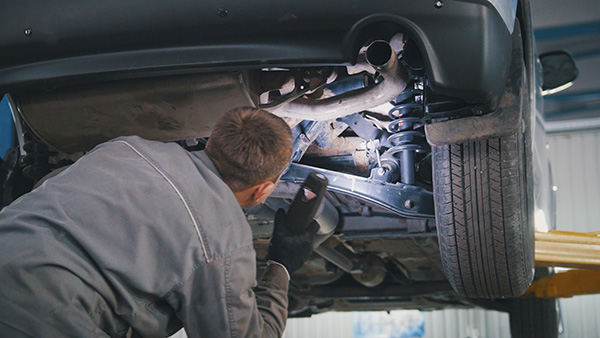
If your car has started feeling loose, clunky, or just not as sure-footed on the road, the problem may lie in something small but important: your suspension bushings. These little rubber or polyurethane parts don’t get much attention, yet they quietly do a lot of work to keep your ride smooth, your steering sharp, and your suspension quiet.
Over time, they wear out. Heat, moisture, road grime, and the constant motion of driving all take a toll. When they do, the result can be a ride that feels sloppy or unstable. Here’s what to look for and why it matters more than you might think.
What Suspension Bushings Actually Do
Bushings sit at the connection points between metal parts in your suspension—control arms, sway bars, shock mounts, and other places where components move or pivot. Their job is to absorb vibration, reduce noise, and allow parts to flex without colliding with each other.
They’re usually made of rubber or synthetic materials that compress slightly when under load. That flexibility smooths out bumps and allows your suspension to move as designed. Without them, every joint would be metal-on-metal, and you’d feel every pebble in the road.
Why Bushings Wear Out
Like brake pads or tires, bushings don’t last forever. Every bump, turn, and pothole wears them down a little more. Road heat, oil, salt, and water accelerate the process, eventually causing the rubber to crack, harden, or shrink.
Polyurethane bushings tend to last longer than rubber, but they can still deform or squeak when they age. Once the cushioning starts to fade, metal parts begin to move around more than they should, creating noise, vibration, and alignment issues.
Common Symptoms of Worn Suspension Bushings
The signs usually creep in slowly, so they’re easy to overlook at first. Here are the most common clues that your bushings might be past their prime:
If you’re noticing any of these, it’s a good idea to have the suspension checked before it causes bigger problems.
Why It’s a Mistake to Ignore Worn Bushings
It’s tempting to think of worn bushings as a small nuisance, but the effects reach farther than you might expect. When bushings no longer hold parts tightly in place, your alignment can shift, your tires can wear unevenly, and handling can become unpredictable.
That extra movement also puts more stress on nearby components like control arms and ball joints. Over time, those parts wear out sooner, turning what could have been a simple fix into a much bigger repair. Replacing worn bushings early often prevents that chain reaction.
How Technicians Check for Worn Bushings
During a suspension inspection, a technician will look for cracks, missing chunks of rubber, or excessive play in the joints. They may gently move or pry parts to see how much flexibility remains. In some cases, the car needs to be lifted for a clear view of the bushings that sit deeper in the suspension.
If the bushings are replaced, an alignment check is usually recommended. It ensures that the wheels are pointing straight again after any movement in the suspension has been corrected.
Can You Keep Driving With Worn Bushings
You probably can, but you may not want to for long. A car with worn bushings often feels noisy, floaty, or unsettled over bumps. The longer you wait, the more wear you place on the tires and other suspension parts.
If the bushings are severely cracked or missing, they can affect your ability to control the car safely, especially during hard braking or quick maneuvers.
Suspension Repair and Inspection in Clifton Park, NY at Gil’s Garage Inc
If your car feels looser than it used to or you’re hearing odd clunks from underneath, it might be time to take a closer look. At Gil’s Garage Inc in Clifton Park, NY, our technicians can inspect your suspension, check for worn bushings, and recommend the best way to restore comfort and stability.
Stop by today and let our team help your car feel solid and confident on the road again.